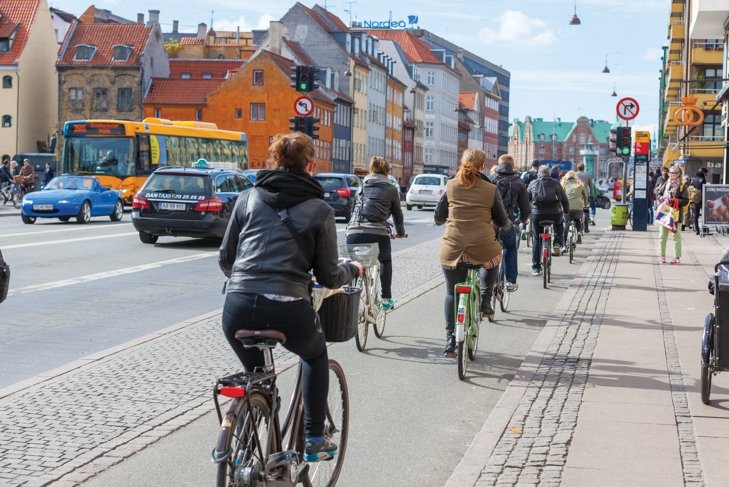
Scandinavia’s thriving commuter bicycle culture isn’t simply a matter of flat terrain and plentiful bike racks. The psychological infrastructure that keeps masses of Danes and Swedes pedalling—and enjoying the many benefits of their choice—is both powerful and transferable.
It’s a drizzly Wednesday morning in Copenhagen, and the bicycle lane outside the Nyhavn Espresso House is thronged. Most of the bikes are basic utility models kitted out with baskets and bells, rat traps and mud-guards. The riders are strikingly diverse: school kids and seniors, bankers and baristas, a dad hauling three kids in a cargo bike, two women smooching at a stop light. Outside the nearby metro station, bicycles huddle together in astonishing numbers, chained to row upon row of public racks that put their dinky North American counterparts to shame.
As a commuter cyclist accustomed to being in the minority, I’m as exhilarated by these sights as I am by Scandinavia’s Viking artifacts and rugged landscapes. Even though my Vancouver home is, by Canadian standards, very bicycle friendly, I fantasize about living in a place where getting around on two wheels is the norm. My holiday in Sweden and Denmark feels like a trip to the promised land.
Far from being a niche transit alternative for the young and fit, or a one-off activity during Bike to Work Week, cycling in Scandinavia is a routine way to get around. For Hanne Nilsson, a Swedish-Danish landscape architect, it’s a fundamental part of her life and identity: “In the city, I cycle everywhere. I can’t imagine living without a bike. It’s like the bike is an extension of me.”
Did you know?
By the 1960s, widespread car use had become a serious threat to Danish bicycle culture. Popular protests and radical changes in city planning led to a cycling renaissance.
Is such a thing possible in Canada?
Watching the Copenhagen bicycle traffic sail by, I can’t help wondering how this vibrant bicycle culture—or a version of it—might be fostered back home.
There’s no denying that climate, geography, and vast networks of segregated bike paths give cyclists in Copenhagen and neighbouring Malmö, Sweden (No. 1 and No. 5 on the “Copenhagenize Bicycle Friendly Cities Index”) a practical edge.
Yet mild temperatures, flat terrain, and abundant urban infrastructure don’t entirely account for Scandinavian bicycle culture. There’s also an important set of values and attitudes at work here. This psychological infrastructure is well worth adopting in Canada, whether we travel by bike, on foot, or by some more wintry mode.
Less is more
Unlike car travel, with its costly and stressful maintenance requirements, or gear-focused sport cycling, Scandinavian bicycle commuting is wonderfully minimalist. Swedish landscape architect and university instructor Christel Lindgren compares her basic utility bike to the ordinary but functional ballpoint pen: “For regular commuting, an old scruffy bike does the job, just like a ballpoint pen—maybe even better than a fancy bike.”
Lotte Ruby of the Danish Cyclists Federation describes the simple, practical commuter bike as being “inextricably linked with freedom”—an attitude that has helped Danish bicycle culture survive and thrive.
Outside is home
The morning drizzle has turned to rain. A woman pedals by, holding an umbrella in one hand. Admittedly not the safest way to ride, but her relaxed pace and posture signal an important quality of Copenhagen bicycle commuters: they don’t let inconvenient weather stop them. Most of them get out there and ride anyway, year round.
The rewards of such regular outdoor time, demonstrated by scientific studies, are impressive: better sleep, reduced stress and improved mental health, increased attention and social interaction, improved eye health, and increased vitamin D levels, to name a few. A more difficult to measure benefit of open-air commuting—one that I’ve experienced—is a stronger sense of connection to both the natural environment and the urban landscape. Nilsson puts it well: “Riding a bike gives me a feeling of belonging in and to the city. I discover places I would never have seen otherwise.”
We’re in this together
Families and stop-light smoochers aside, most of Copenhagen’s rush-hour cyclists are clearly commuting solo, destined for different places. And yet, the density and harmony of the parade, as well as the absence of physical barriers between the bikes, suggest that they’re travelling together—participating in the kind of democratic enterprise for which Scandinavia is known.
In a sense, this togetherness extends beyond the bike paths. Danish-Australian cycling enthusiast Jonas Christensen points out that most Danish motorists are also cyclists. This dual identity, he writes, “creates a different level of respect” on the roads. Michael Friesen, a North Vancouver city planner with ties to Sweden, maintains that “the lack of conflict between the various transportation modes” is the most striking difference between Scandinavian and Canadian transit attitudes.
The temptation to experience cycling in Scandinavia first-hand is irresistible. In Malmö, my travel companions and I rent three-speed cruisers from a bike-share station and follow the rental company’s cheerful command to do what the locals do—cycle! We go with the flow, along busy bike lanes that seem to line every street, past cafés and parks, centuries-old public squares, and innovative eco-friendly residences.
Inside the crowd, I’m part of an energizing collective force. And I wonder: does travelling in this way remind us of the bigger journeys we share with our fellow humans—through the seasons, through cultural and political change, through life? Maybe it helps us feel less alone in the world.
Canadians have some distance to go before their commuting habits rival those of Scandinavia. But the trip will be worth it.
How much cycling do those Danes really do?
- Every day, Copenhagen residents collectively cycle the equivalent of 35 trips around the world.
- Only 40 percent of Danes own a car (90 percent own a bike).
- Cycling accounts for 26 percent of trips under 5 km and 16 percent of all trips.
- 49 percent of Danish children aged 11 to 15 cycle to school.
How to “Copenhagenize” your commute
Keep it simple
If you’re in need of a bike or other gear, look for something basic that will do the job.
Start small
Once a week or once a month, aim to travel, even part way, on your own steam.
Recruit friends
Organize a “bikepool” or “walking school bus.”
Take it all in
Pay attention to the world around you; savour this time away from keyboards, screens, and other distractions.
Think ahead
Prepare for the weather. Make transit options a priority when choosing where to live.
Get help and get involved
Seek out bicycle advocacy groups in your community.











